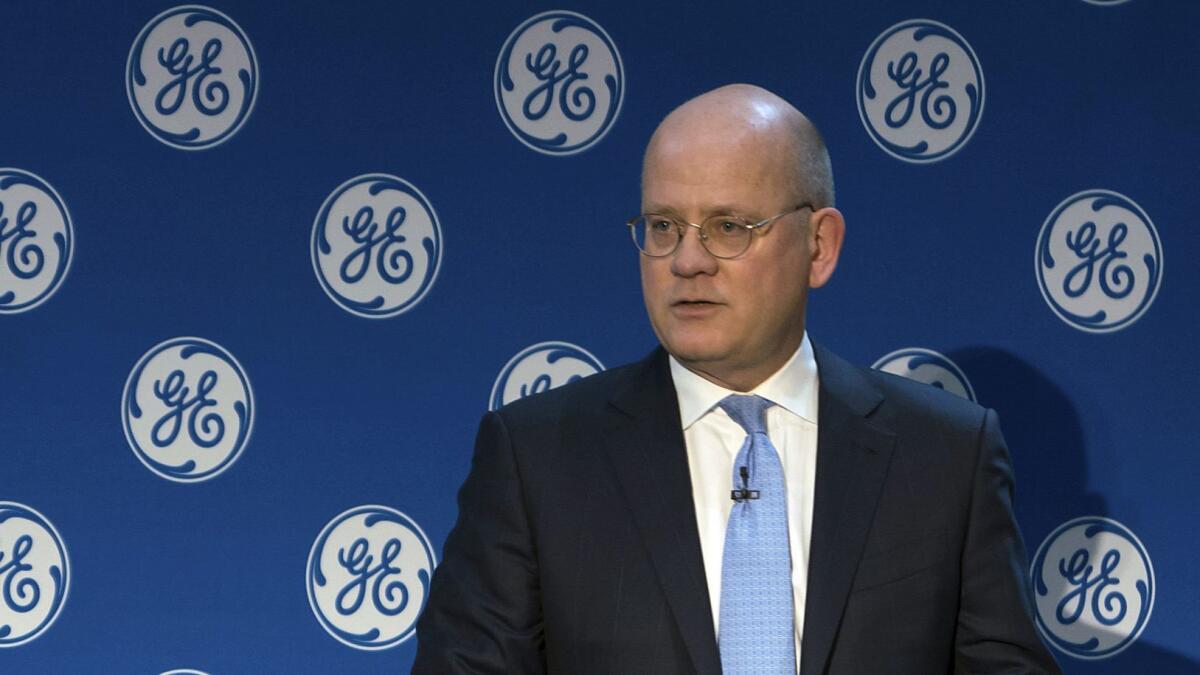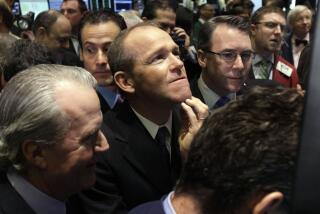General Electric ousts its CEO as it seeks a path forward

General Electric Co. ousted its Chairman and Chief Executive John Flannery, who took over the industrial giant just over a year ago, abruptly replacing him Monday with H. Lawrence Culp Jr., former chief executive of Danaher Corp. The company also said it will take a $23-billion noncash charge for its power business and fall short of earnings expectations in 2018.
GE stock jumped 7.1% to $12.09 a share.
The shares have declined significantly in the last year even as the stock market overall has touched record highs. The company’s stock price fell by half, and its market capitalization declined to less than $100 billion. Since its peak 18 years ago, GE has shed half a trillion dollars in market value — the equivalent of erasing Facebook Inc.
Flannery replaced longtime CEO Jeffrey Immelt, whose tenure marked GE as the worst-performing stock in the Dow Jones industrial average among companies that hadn’t gone bankrupt or left the group of blue-chip stocks.
GE — maker of lightbulbs, appliances, turbines and the onetime owner of NBCUniversal — has touched the lives and investment portfolios of hundreds of millions of Americans and consumers worldwide. Because of the company’s size, for decades the U.S. economy and millions of pensioners, savers and investors have depended on the success of its stock price and dividend.
Flannery began his career at GE in 1987. He climbed the ranks to president and CEO of the company’s healthcare business before assuming the top job.
Long admired for its management, GE has been mired in underperforming divisions and poorly timed acquisitions for years. In the past year, it sold its locomotive business and divested its Baker Hughes oil investment to raise money.
But its board of directors demanded results faster than Flannery was able to deliver.
Culp, who was named to GE’s board this year, is the first leader of General Electric since its original president and chairman who has not spent years working for the company before ascending to its helm. Culp is only the 14th person to run the 126-year-old company, with its most recent chief executives holding onto the job for nine to 20 years. The company’s CEO successions have been among the most widely watched events in corporate America, making the sudden handoff to Culp all the more notable.
Although one year is a short tenure by nearly any corporate standard — the average CEO lasts just under nine years, according to the Conference Board — it is particularly abbreviated at a company like GE, which has long been heralded for its reputation for developing corporate executives and seen its management practices become widely copied.
“Here’s the company that was the role model for well over 100 years of being able to generate leadership talent, and they didn’t have someone on the bench that the board felt comfortable moving in,” said Noel Tichy, a professor at the University of Michigan’s business school who led GE’s leadership training center, known as “Crotonville,” in the mid-1980s and has written widely about succession, corporate leadership and GE.
Culp, who retired as CEO of industrial giant Danaher in 2015, led that company for 14 years, a management run the Wall Street Journal called “among the most successful in corporate America over the past decade” in 2014. During his tenure, Danaher’s revenue and market capitalization grew about fivefold, and returns to shareholders well outpaced the Standard & Poor’s 500 index.
“GE remains a fundamentally strong company with great businesses and tremendous talent. It is a privilege to be asked to lead this iconic company,” Culp said in a statement. “We will be working very hard in the coming weeks to drive superior execution, and we will move with urgency.”
GE also installed Thomas Horton, former CEO of American Airlines, as its lead director, succeeding former Vanguard CEO John “Jack” Brennan, a director who said this year that he would not stand for reelection in 2019. The lead director position represents the board’s independent board members and is common in publicly traded companies where the chairman is also a current or former CEO. As CEO at American, Horton led the airline’s restructuring and its merger with US Airways.
The board of directors that named Flannery CEO in June 2017 now looks very different. Just seven directors from that 18-member board remain after the company announced an overhaul in February. It added three independent directors — including Culp and Horton — but said goodbye to eight others, reducing the board to just 12 members and marking a kind of wholesale shift that is rarely seen in corporate governance. (GE’s board now has 11 directors with Flannery’s departure; the company also named Edward Garden late last year amid pressure from activist investor Nelson Peltz and saw two other board members step down.)
“This is a board that’s not loyal to anybody now,” said Peter Crist, chairman of the executive search firm Crist Kolder Associates who has been a longtime observer of GE.
“Boards get impatient, and new boards are doubly impatient in a troubled situation,” Crist said. “They have no legacy heritage to the company, and they demand change.”
General Electric had long been a pillar of U.S. industry. It has 300,000 employees, competes in 180 countries, and received wide respect for its management and corporate governance.
But the firm stumbled under the reign of Immelt, who retired in 2017 after 16 years in the top spot. Immelt had succeeded Jack Welch, a legend in corporate management circles.
GE’s fall from its stock’s August 2000 peak has come in fits and starts. The 9/11 terrorist attack badly hurt the company’s jet-engine and insurance businesses, for instance. But the last couple years have been particularly brutal.
The shares fell 45% in 2017 after cash-flow shortages and weak sales in its power unit, among other factors. They’ve crashed an additional 30% so far this year. The decline earned the century-old company an unwelcome boot from the Dow Jones industrial average in June, leading to yet more selling.
In mid-September, the shares took a sharp dive when new questions arose over the company’s critical power segment business. Investors were spooked by GE’s acknowledgment that its flagship gas turbine was suffering from an “oxidation issue” that prompted a customer to temporarily shut down two U.S. power plants.
GE has identified a fix and says the situation is under control. But last week’s slide shows how “there’s very little wiggle room for incrementally bad news,” JPMorgan Chase & Co. analyst Steve Tusa said.
Flannery had been working to restore confidence. After his appointment in August 2017, several top managers left the company, including the chief financial officer.
Flannery subsequently grounded the company’s corporate jet fleet, reduced the number of cars issued to executives and announced a review of its compensation policies. Still, the company reported disappointing financial results soon after he took over. It cut its dividend by half as it sought to save money and regain its footing after more than a decade of lagging profits and poor stock performance.
Shareholders’ payments on each share dropped to 12 cents per quarter from 24 cents, just the third time the company has cut the payout in its 125-year history. GE had long been one of Wall Street’s biggest dividend payers, behind the likes of Exxon and Apple.
The manufacturing conglomerate put in motion a sweeping overhaul that includes plans to revamp its board of directors and sell off business units, including its storied lighting business that dates to its founder, Thomas Edison.
Restoring GE as a strong company probably will mean additional painful changes.
Culp “is going to look at the portfolio and say, ‘This is a keeper, this isn’t,’ and orchestrate the change,” Crist said.
“He is a really smart, dispassionate, strategic CEO,” Crist said. And investors are likely to “view him as the right set of hands that can steer this without any of the emotion of the past.”
Heath writes for the Washington Post. Richard Clough, who writes for Bloomberg, contributed to this report.
UPDATES:
2:35 p.m.: This article was updated throughout with additional details.
1 p.m.: This article was updated throughout with additional details.
This article was originally published at 4:45 a.m.
More to Read
Inside the business of entertainment
The Wide Shot brings you news, analysis and insights on everything from streaming wars to production — and what it all means for the future.
You may occasionally receive promotional content from the Los Angeles Times.










